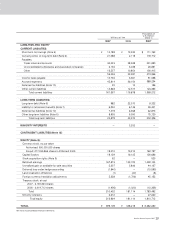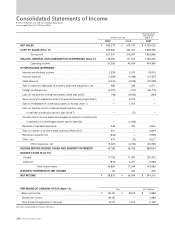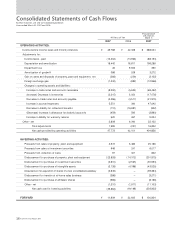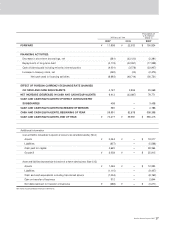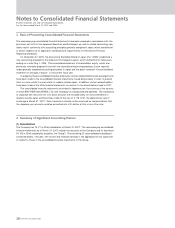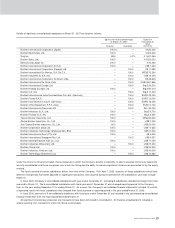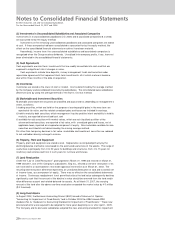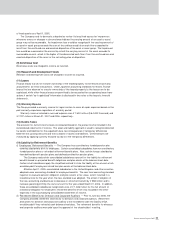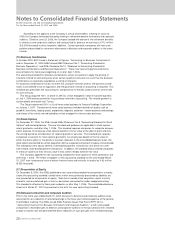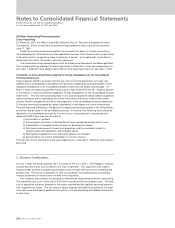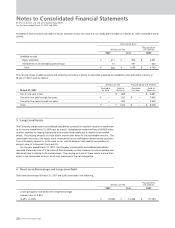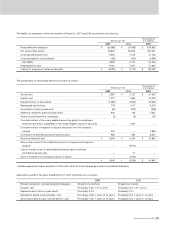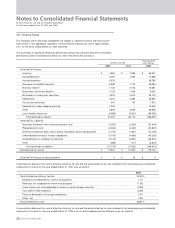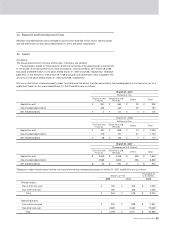Brother International 2007 Annual Report Download - page 25
Download and view the complete annual report
Please find page 25 of the 2007 Brother International annual report below. You can navigate through the pages in the report by either clicking on the pages listed below, or by using the keyword search tool below to find specific information within the annual report.
23
Brother Annual Report 2007
after approval of the appropriation of retained earnings.
The ASBJ replaced the above accounting pronouncement by issuing a new accounting standard
for bonuses to directors and corporate auditors on November 29, 2005. Under the new accounting
standard, bonuses to directors and corporate auditors must be expensed and are no longer
allowed to be directly charged to retained earnings. This accounting standard is effective for fiscal
years ended on or after M ay 1, 2006. The companies must accrue bonuses to directors and
corporate auditors at the year end to w hich such bonuses are attributable.
The Company and domestic consolidated subsidiaries adopted the new accounting standard
for bonuses to directors and corporate auditors from the year ended March 31, 2007. The effect
of adoption of this accounting standard w as to decrease income before income taxes and minority
interests for the year ended M arch31, 2007 by ¥ 71 million ($ 602 thousand).
(19) Appropriations of Retained Earnings
Appropriations of retained earnings at each year-end are reflected in the financial statements for
the following year.
(20) Foreign Currency Transactions
All short-term and long-term monetary receivables and payables denominated in foreign currencies
are translated into Japanese yen at the exchange rates at the balance sheet date. The foreign
exchange gains and losses from translation are recognized in the statements of income to the
extent that they are not hedged by forward exchange contracts.
(21) Foreign Currency Financial Statements
The balance sheet accounts of the consolidated foreign subsidiaries are translated into Japanese
yen at the current exchange rate as of the balance sheet date except for equity, w hich is translated
at the historical rate.
Differences arising from such translation are show n as "Foreign currency translation adjustments"
in a separate component of the equity and included in minority interests.
Revenue and expense accounts of consolidated foreign subsidiaries are translated into yen at
the average exchange rate during the year.
(22) Derivative and Hedging Activities
The Group uses derivative financial instruments to manage its exposures to fluctuations in foreign
exchange and interest rates. Foreign exchange forward contracts, interest rate sw aps and currency
option contracts are utilized by the Group to reduce foreign currency exchange and interest rate
risks. The Group does not enter into derivatives for trading or speculative purposes.
Derivative financial instruments and foreign currency transactions are classified and accounted for
as follows:
a) all derivatives are recognized as either assets or liabilities and measured at fair value, and gains or
losses on derivative transactions are recognized in the statements of income and
b) for derivatives used for hedging purposes, if derivatives qualify for hedge accounting because of
high correlation and effectiveness betw een the hedging instruments and the hedged items,
gains or losses on derivatives are deferred until maturity of the hedged transactions.
Foreign currency contracts and currency option contracts employed to hedge foreign exchange
exposures are measured at fair value and unrealized gains (losses) are recognized in income.
Foreign currency forw ard contracts and currency option contracts used to hedge forecasted (or
committed) transactions are also measured at fair value but the unrealized gains (losses) are
deferred until the underlying hedged transactions are completed.
The interest rate sw aps that qualify for hedge accounting and meet specific matching criteria
are not remeasured at market value but the differential paid or received under the sw ap agreements
are recognized and included in interest expense or income.
(23) Per Share Information
Basic net income per share is computed by dividing net income available to common shareholders
by the w eighted average number of common shares outstanding for the period, retroactively
adjusted for stock splits.
Diluted net income per share reflects the potential dilution that could occur if securities w ere
exercised. Diluted net income per share of common stock assumes full exercise of outstanding
warrants at the beginning of the year (or at the time of issuance).
Cash dividends per share presented in the accompanying consolidated statements of income are
dividends applicable to the respective years including dividends to be paid after the end of the year.


